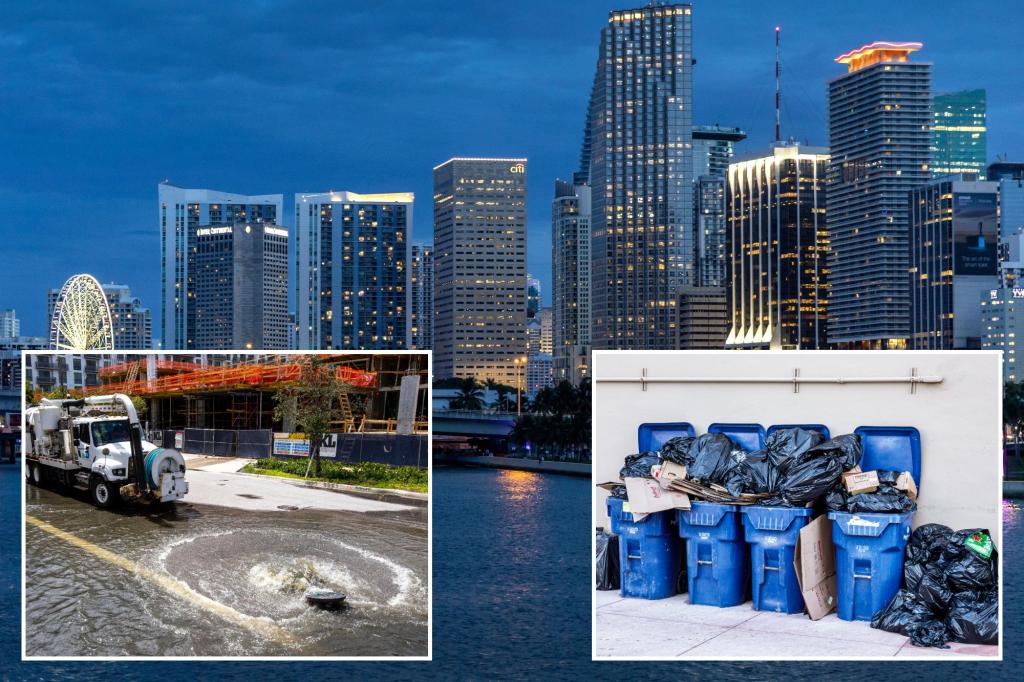Miami’s COVID-induced boom — much of it fueled by an exodus from New York — may screech to a halt because of mounting piles of trash and overflowing septic tanks, according to a report.
The public health risk posed to both the residents and the environment has paused construction on new housing and threatens to raise taxes on existing homeowners, Bloomberg News reported.
Higher taxes would be a bitter pill for the hundreds of thousands of transplants — some 65,000 from New York state last year alone — from around the country who decamped to Florida since the pandemic to bask in the Sunshine State’s relaxed COVID regulations.
Those that landed in Miami-Dade County could see their tax bills spike in order to fund the costly transition from the septic tanks used by some 108,000 homes — from the wealthy enclaves of Coral Gables and Miami Beach to middle-class areas south of the city — to a sewer system, according to Bloomberg News.

“It’s unbelievable, not just to me but to most of the planning and environmental community, that you can have a county as urban as Miami-Dade and not have everybody on water and sewer,” Howard Nelson, who heads the environmental practice at Bilzin Sumberg, told Bloomberg
The local government’s inability to solve the sewage crisis faced by a population of 2.7 million has forced a moratorium on new construction in places such as Belle Meade Island, a posh area hugging Biscayne Bay where homes sell for $10 million or more.

South Florida’s infamously heavy rainfall often causes septic tanks to overflow, which results in the release of fecal bacteria and other contaminants into the groundwater, which is higher due to rising sea levels.
The county has already spent $1 billion on water and sewer lines. Miami-Dade County Mayor Daniella Levine Cava’s budget has allocated another $160 million.
The overall price tag for getting rid of septic tanks throughout the county could extend beyond $4 billion, according to government estimates.
It could cost homeowners on average $20,000 each to connect their properties to sewer lines, Cava has said.
On top of the sewage issues, several of Miami-Dade County’s large landfills, some carrying nicknames like Mount Trashmore, will run out of space by 2026, according to a report commissioned by Cava.

Local law requires at least five years of garbage disposal capacity in order to issue building permits.
Cava’s solution is to pile trash higher.
That idea apparently didn’t sit well with Cava’s solid waste director Michael Fernandez, who abruptly quit in July, warning that the county won’t have enough space for trash if Cava doesn’t act fast, according to Bloomberg.
“At this point, the County will have to issue a moratorium to stop all development,” he wrote in his resignation letter, Bloomberg reported.
Cava, a Democrat and the first woman to lead Miami-Dade County after her election win in 2020, has disputed that assessment, according to the outlet.
She has proposed building a $1 billion incinerator and power plant that would process some 1 million tons of trash per year.
“It’s very critical,” said Cava of the infrastructure hurdles facing the county. “We have to address all of that aggressively.”
𝗖𝗿𝗲𝗱𝗶𝘁𝘀, 𝗖𝗼𝗽𝘆𝗿𝗶𝗴𝗵𝘁 & 𝗖𝗼𝘂𝗿𝘁𝗲𝘀𝘆: nypost.com
𝗙𝗼𝗿 𝗮𝗻𝘆 𝗰𝗼𝗺𝗽𝗹𝗮𝗶𝗻𝘁𝘀 𝗿𝗲𝗴𝗮𝗿𝗱𝗶𝗻𝗴 𝗗𝗠𝗖𝗔,
𝗣𝗹𝗲𝗮𝘀𝗲 𝘀𝗲𝗻𝗱 𝘂𝘀 𝗮𝗻 𝗲𝗺𝗮𝗶𝗹 𝗮𝘁 dmca@enspirers.com


